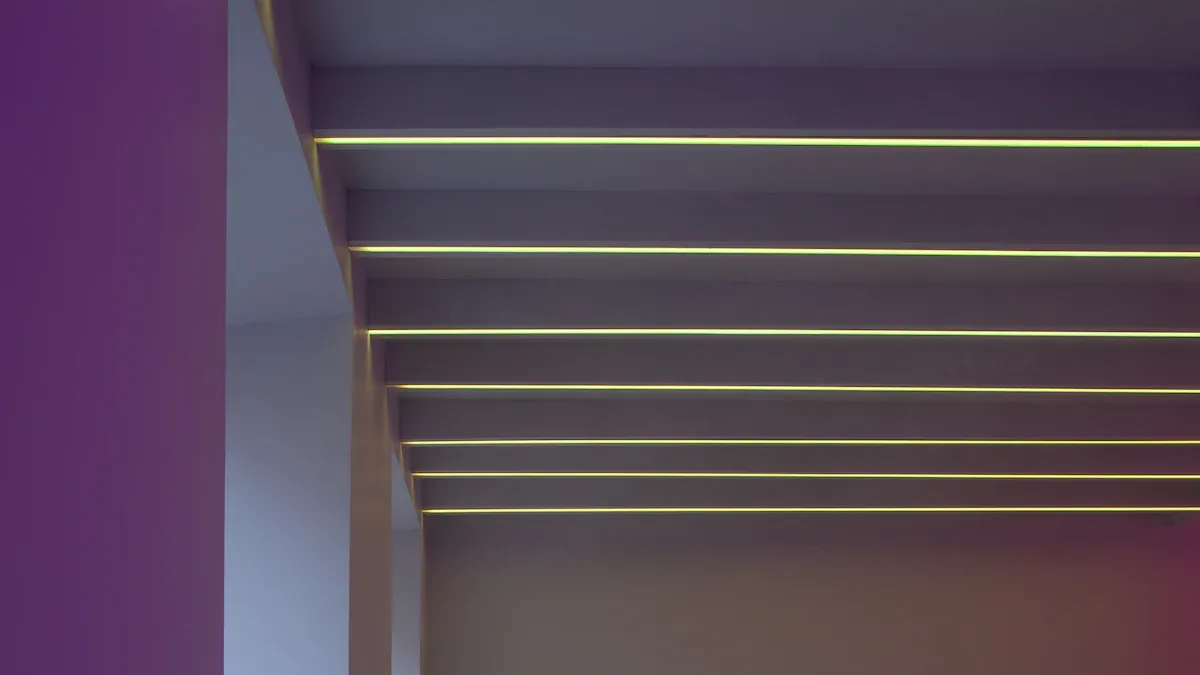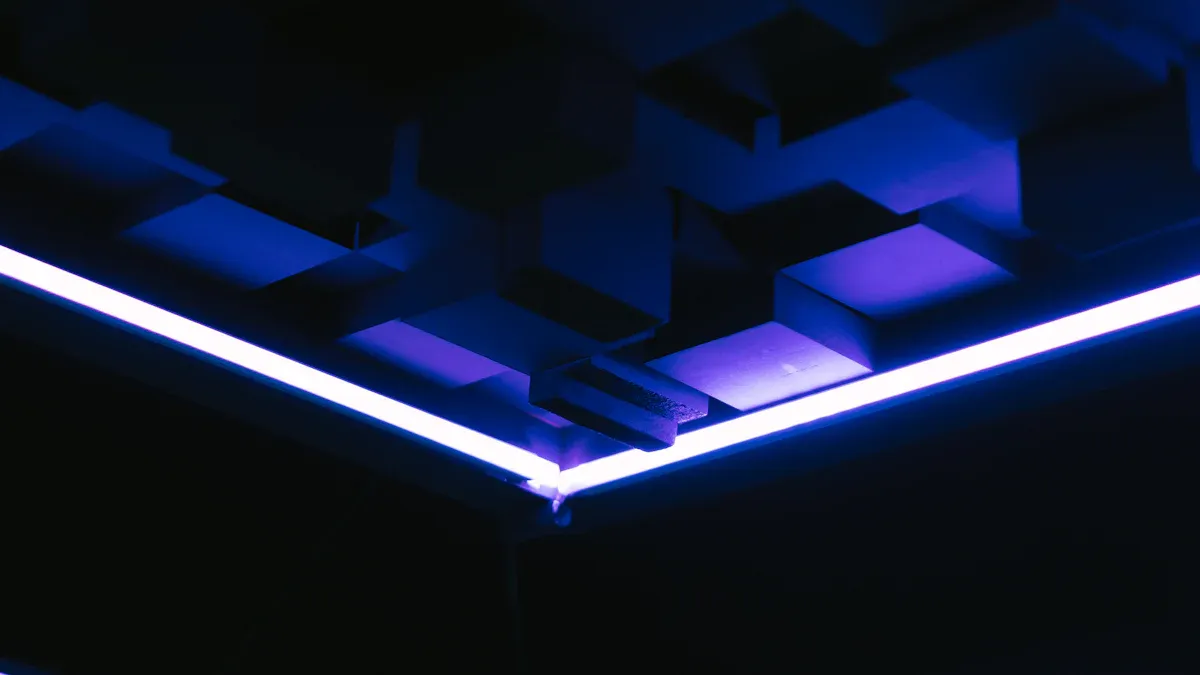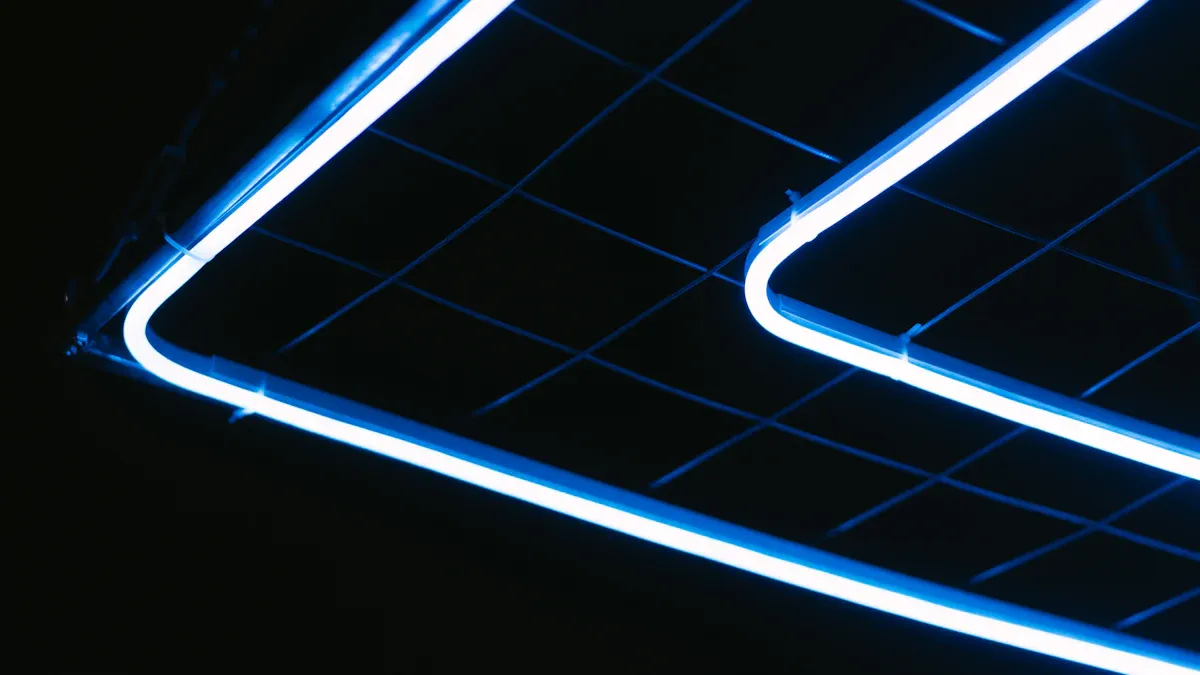LED Stick Lights: Types, Applications, and Installation Tips

LED stick lights are a fantastic product that not only save a lot of energy but also enhance the aesthetics of modern spaces. These solar lights are incredibly versatile, serving both functional and decorative purposes. They consume up to 75% less energy than traditional lights, making them an efficient choice for any home. With a lifespan of up to 50,000 hours, these LED lights are becoming increasingly popular, contributing to a projected LED market value of $108.32 billion by 2027. You can easily incorporate them into homes, offices, or outdoor areas. They provide bright illumination, are user-friendly, and significantly help reduce electricity bills, all while being environmentally friendly.
Key Takeaways
LED stick lights use 75% less energy than old lights. They are a smart and cheap option for homes and offices.
Pick the right LED stick lights for your needs. Use SMD lights for decoration or COB lights for smooth cabinet lighting.
Installing them is easy: clean the area, measure and cut the lights, then connect to power. Use proper tools for better results.
Think about brightness (lumens) and color (Kelvin) when choosing lights. This helps set the mood you want in your room.
Clean and check connections often to keep LED stick lights working well and lasting longer.
Types of LED Stick Lights

Design Variations
LED stick lights come in many styles for different uses. Some common types are:
SMD LEDs (Surface-Mounted Diodes): These are flexible and come in various sizes. They are great for decorative and accent lighting.
COB LEDs (Chip-on-Board): These give smooth light and are perfect for sleek setups like under cabinets.
Filament LEDs: These look like old-fashioned bulbs but save energy with modern tech.
RGB and RGBW LEDs: RGB mixes red, green, and blue for bright colors. RGBW adds white for better brightness and color accuracy.
Tunable White LEDs: These let you change the light's color tone to match your mood.
Tip: Want flexibility? Pick LED stick lights that can be cut. This lets you adjust their length for tricky spots like curved walls or grooves.
Functional Features
LED stick lights have features that make them easy to use:
Portable and Wireless: Great for outdoor spaces, emergencies, or places without outlets.
Energy-Efficient: They use little power but shine brightly, saving money on bills.
Waterproof and Durable: Many are made for outdoor use, so they work well in bathrooms, kitchens, or patios.
Remote and Motion Sensor Control: Some come with remotes or sensors for easy and automatic control.
These features make LED stick lights useful for both lighting and decoration.
Voltage and Power Options
Knowing the voltage and power needs of LED stick lights helps them work best. Most run on 12V DC or 24V DC, which are safe and save energy. A 5-meter roll of LED stick lights usually uses 72 watts of power.
Here’s a simple chart of key details:
Specification | Details |
|---|---|
Power Consumption | A 5m roll uses 72 watts of power. |
Voltage Requirements | Usually rated at 12V DC or 24V DC. |
Lumens per Foot | Good-quality LEDs give at least 450 lumens per foot. |
Dimmability | Dimmable ones need special dimmer switches to work right. |
Note: To find power use, multiply voltage (in volts) by current (in amps). For example, an LED with 3.6V and 20mA uses 72 milliwatts of power.
LED stick lights come in different voltage and power options, making them fit for homes or businesses.
Brightness and Color Temperature
When picking LED stick lights, knowing brightness and color temperature is key. Brightness, measured in lumens, shows how much light they give. More lumens mean brighter light. For example, good-quality LED stick lights provide 450 lumens per foot. This makes them great for both work and general lighting.
Color temperature, measured in Kelvin (K), affects how the light looks. Lower Kelvin, like 2700K, gives warm, yellow light. This feels cozy and calm. Higher Kelvin, like 5000K or 6000K, gives cool, blue light. This feels bright and energizing. Both 5000K and 6000K lights are equally bright. Choose based on the mood you want. Warm tones are nice for bedrooms or living rooms. Cool tones work better in kitchens, offices, or garages.
For more control, try tunable LED stick lights. These let you change the color temperature as needed. For example, use warm light at night and cool light for daytime tasks. This makes tunable lights a favorite for modern homes and offices.
Tip: Always read the lumens and Kelvin details on the box. This helps you pick the right lights for your space and style.
By learning about brightness and color temperature, you can choose wisely and improve your lighting setup.
Applications of LED Stick Lights

Home Lighting
LED stick lights make your home look better and brighter. Use them under cabinets to light up kitchen counters. Place them on stairs to make walking safer. They fit well in closets, giving clear light without taking space. Their slim shape works in tight spots like under shelves or inside drawers. If you love decorating, use them to show off art or make your living room cozy. Dimmable and color-changing options let you set the mood easily.
Office and Commercial Spaces
LED stick lights are great for offices and businesses. They save money by using less electricity and lasting longer. Fewer replacements mean saving time and storage space. These lights use up to 90% less energy than old bulbs. This helps the environment and improves your brand's image. Use them for bright work areas or soft lighting for displays. They are a flexible and smart choice for any business.
Outdoor and Landscape Uses
LED stick lights work well outside too. They light up paths, driveways, and doors for safety. Studies show they save energy and need less upkeep. Use them to make gardens and patios look nice and inviting. Smart features let you control brightness and timing to save power. They are strong and weatherproof, so they last all year. With LED stick lights, your outdoor space can be safe and stylish.
Specialized Applications
LED stick lights are useful beyond homes and offices. They work well in areas needing precision and flexibility. Industries, healthcare, and creative fields benefit from these lights.
Industrial Use: Factories use LED stick lights for detailed tasks. Their slim shape fits tight spots like under machines. Workers can see clearly while working. These lights are tough and handle dust and vibrations easily.
Healthcare Settings: Hospitals use LED stick lights for medical tools and exam rooms. They give bright light for accurate procedures. These lights save energy, lowering costs for healthcare centers.
Retail Displays: Stores use LED stick lights to show off products. They make colors look vibrant and details stand out. You can adjust brightness to match your display's mood.
Photography and Videography: Photographers and videographers love LED stick lights. They give steady light and adjustable colors for great visuals. Use them for product photos, interviews, or creative shoots.
Tip: Always check the specs of LED stick lights for special uses. Make sure they meet your needs for brightness, color, and durability.
These lights are helpful in many fields, solving unique problems with ease.
Installation Tips for LED Stick Lights
Getting the Surface Ready
Make sure the surface is clean and smooth for proper installation. Follow these steps:
Wipe the surface to remove dust, dirt, and grease.
Let the surface dry completely before sticking the lights.
For bumpy surfaces, use screws or clips instead of sticky tape.
Tip: If walls have peeling paint, sand them lightly and repaint. This gives a smooth surface for better sticking.
Tools and Materials You’ll Need
Using the right tools makes installing LED stick lights easier. Check this table for what you need:
Tool/Material | Suggested Type | Cost Range |
|---|---|---|
Soldering Iron | 25-40W with heat control | $30-$100 |
Wire Stripper | Works with 20-30 AWG wires | $15-$30 |
LED Tester | 12V/24V, tests RGB lights | $20-$50 |
Digital Multimeter | Measures DC voltage and continuity | $25-$75 |
Corner Connectors | Match strip type (2-6 pin) | $3-$10 each |
Note: Always check your tools match your LED lights. Wrong tools can damage the lights or make them work poorly.
Easy Steps to Install
Follow these simple steps to set up your LED stick lights:
Measure and Cut: Measure where the lights will go. Cut the strip to fit using scissors.
Add Connectors: Use corner connectors for turns or joining strips. Align pins properly to avoid dark spots.
Stick the Lights: Peel off the backing and press the lights onto the surface. Make sure they stick firmly.
Connect Power: Attach the lights to the power source. Use a multimeter to check voltage before turning them on.
Test and Fix: Turn on the lights to see if they work. Adjust their position if needed for the best look.
Tip: Use a dimmer switch if your LED stick lights are dimmable. This helps you control brightness easily.
Avoiding Common Mistakes
Setting up LED stick lights is simple, but mistakes can happen. These errors might cause the lights to break or not work well. Knowing what to avoid can save you time and trouble.
Here are some common mistakes and what they can cause:
Common Mistakes | Consequences |
|---|---|
Bending strips too much | Broken circuits or damaged LEDs |
No heat sink for high-power strips | Overheating, color changes, or early burnout |
Mounting on surfaces that trap heat | Shorter lifespan of the lights |
Using staples to secure strips | Damage to the strip, leading to failure |
To avoid these problems:
Be gentle with the strips. Don’t bend them sharply, as this can break the circuits inside.
Use heat sinks for high-power strips. They help keep the lights cool and prevent overheating.
Don’t stick the lights on surfaces like plastic or wood without airflow. Trapped heat can make them wear out faster.
Use adhesive tape or clips to hold the lights in place. Staples can poke holes in the strips and ruin them.
Tip: Always check the instructions from the manufacturer. This helps you install the lights correctly and avoid mistakes.
Troubleshooting and Maintenance
Even when installed carefully, LED stick lights might have problems. Knowing how to fix and care for them can save you money and effort.
Common Problems and Fixes
Lights Won’t Turn On
Check if the power supply is connected and working.
Look for loose or broken wires. Fix or replace them if needed.
Lights Are Uneven
Make sure all connectors are tight. Loose ones can cause uneven light.
For long strips, add extra power supplies to keep brightness even.
Lights Flicker
Flickering happens with the wrong dimmer switch. Use one made for LEDs.
Check if your power source has voltage changes. A stabilizer can help.
Lights Get Too Hot
Make sure there’s enough airflow around the lights. Remove anything blocking heat.
If they still overheat, upgrade the power supply or add heat sinks.
Maintenance Tips
Clean Often: Dust can make the lights dim. Wipe them gently with a soft cloth.
Check Connections: Look at wires and connectors for damage. Replace bad parts quickly.
Turn Off When Not Needed: This saves energy and makes the lights last longer.
Store Safely: If you take the lights down, keep them in a dry, cool place.
Note: Regular care keeps your LED stick lights working well and lasting longer.
By avoiding mistakes and following these tips, your lights will stay bright and reliable for years.
LED stick lights are super flexible for today’s lighting needs. Use them at home, in offices, or outside for style and function. They come in many types, like tunable or waterproof, to suit any place. Installing them is easy with simple tools and prep work. These lights save energy and last long, making them budget-friendly and good for the planet.
Try LED stick lights now to upgrade your space simply and stylishly.
FAQ
1. How can you pick the best LED stick lights?
Check how bright they are (lumens) and their color tone (Kelvin). Look for features like dimming options. Make sure the voltage and power match your setup. For outdoor areas, choose waterproof lights.
Tip: Always read the product label to ensure it fits your needs.
2. Can you shorten LED stick lights for tight spaces?
Yes, most LED stick lights can be trimmed at marked spots. Use scissors or a sharp knife to cut them. After cutting, reconnect the ends with connectors to keep them working.
Note: Cutting outside the marked spots can damage the lights.
3. What tools are needed to install LED stick lights?
You’ll need tools like a soldering iron, wire stripper, and multimeter. Adhesive tape helps stick the lights, and corner connectors are useful for turns. For outdoor setups, use waterproof materials.
Tool | What It’s For |
|---|---|
Soldering Iron | Secures wire connections |
Multimeter | Checks voltage and wires |
4. Why do LED stick lights sometimes flicker?
Flickering happens if the dimmer switch isn’t made for LEDs. It can also occur if the power source is unstable. Use dimmers designed for LEDs and check for power issues.
Tip: A stabilizer can help fix flickering caused by power changes.
5. How do you take care of LED stick lights?
Wipe them gently with a soft cloth to remove dust. Check wires and connectors for any damage. Turn them off when not in use to make them last longer. Store unused lights in a dry, cool place.
Reminder: Regular care keeps your lights bright and working longer.
See Also
Exploring LED Flood Lights: Varieties, Uses, and Advantages
Understanding LED Area Lights: Uses, Perks, and Setup Tips
A Comprehensive Overview of LED Area Lights: Varieties and Uses
LED Replacement Lighting: Varieties, Advantages, and Setup Guide
Outdoor LED Lighting: Varieties, Advantages, and Installation Advice

